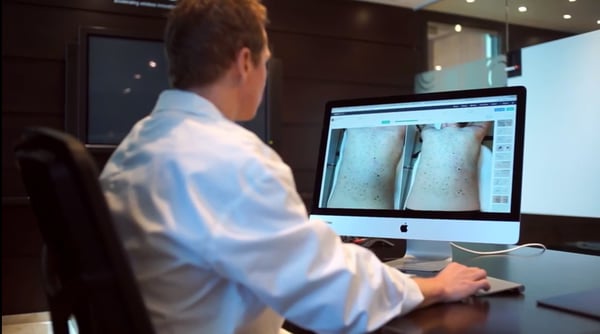Total Body Photography: Overcoming Challenges For Widespread Application
Total body photography (TBP) has grown in popularity given its impact on skin cancer early detection.1 This article will review solutions to overcome current operational challenges for the broader accessibility and implementation of this technique in the future.
1. The efficacy of total body photography in skin cancer detection
Total Body Photography (TBP) can play a pivotal role as a general first defence mechanism against skin cancer. Statistics show that 80% of melanomas develop from new spots rather than existing ones and that probabilities are higher in patients 40 years old and above.2 Having the ability to photograph every body part provides the advantage to tackle cancer from its earliest stages. By allowing dermatologists to perform a more detailed assessment of changing spots, Total Body Photography (TBP) provides them with a greater level of control towards the patient’s ongoing skin health. As a result, every area of skin can be monitored for any concerns, while the focus is placed on those spots that show the greatest amount of change to follow them with closer attention.
From a technical standpoint, Total Body Photography (TBP) has faced several operational transformations over the years - from individual cameras to dedicated multi-imaging robots or even automated imaging drones are all part of the new trends within the field. This technological variety is looking to provide the basis for a stronger consistency of Total Body Photography (TBP) that allows the practice to be standardized in everyday services. However, as new methods and innovations arise there remains a need to optimize procedures in an attempt to overcome some of the most common technical challenges and effectively contribute to the ongoing fight against skin cancer.
.png?width=600&name=Total%20Body%20Photography%20Feature%20On%20DermEngine%20for%20MoleMapping%20(1).png)
The technology behind Total Body Photography (TBP) can pose several challenges that become barriers to a widespread implementation of this technique.
1- Image colour variation: since Total Body Photography (TBP) is based on image comparison, colour changes can have a profound impact on skin lesion assessment and identification. This makes it imperative to have a white balance procedure where all images are normalized against a standard tone, thus reducing errors introduced through colour fluctuations.
2- Patient changes: this represents another area of variability that is difficult to normalize. Weight gain or loss, skin tone changes, clothing and accessories according to seasonality all represent sources of fluctuation. While skin tone can be remedied with white balancing images, others are inherent variables of the technique.
3- Patient privacy: Total Body Photography TBP imaging implies the photographing of large areas of the body, for which the patient will have completely exposed skin. There may be cases of personal preference or cultural tradition that oppose such practices. An example might be a patient refusing to have their face photographed. In such cases, the risk of missing potential skin lesions in the areas not covered can increase significatively and be remedied by obtaining consent from the patient or having private, not photographed skin examinations of those areas
4- Content security: the cloud-based nature of DermEngine and other software can become a challenge for some dermatologists. Uploading patient information might represent a privacy issue as individuals may not agree to have their body images stored in remote servers. Dermatology EMR application of privacy and security protocols are expected to comply with international regulations on data handling such as HIPAA that guarantee safe accessibility as well as proper disposition of it.
5- Technical issues: miscellaneous technical challenges can arise, such as the uploading speed of pictures to the analyzing software platform. For these practices, the size of multimedia files can be a real challenge in terms of connectivity loading speed, for which equipping clinics and consultation rooms with the minimum technical requirements must remain a priority for offering effective Total Body Photography (TBP) services.
Conclusion
In the few decades that Total Body Photography (TBP) has been employed in dermatology, a lot has changed for the better of doctors and patients. On one hand, the advantages are clear as per tackling potential serious skin lesions arising on any part of the body at an early stage. On the other hand, certain technical and operational challenges remain unresolved, slowing down the general adoption of this practice across different practices. Overall, Total Body Photography (TBP) is the method of preference for whole body exams in search of life-threatening diseases, such as melanoma. Being able to expand its utility while identifying key pain points can drive the efforts and resources in an attempt to keep developing a major life-saving technique in dermatology services.
-The MetaOptima Team
Would you like to stay updated on the latest news of MetaOptima and its Total Body Photography solution? Subscribe to our blog below! If you're ready to experience the most advanced Total Body Photography features available on DermEngine, request your demo today!

Sources
1-http://www.dermatologytimes.com
2-https://www.aad.org
Topics: Dermatology Skin Cancer Total Body Imaging Total Body Photography Advanced Dermatology Advanced Teledermatology EMR Dermatology EMR Dermatology Software Teledermoscopy Dermatology EMR Software EMR Software Mobile Dermoscopy Skin Imaging System EMR System





